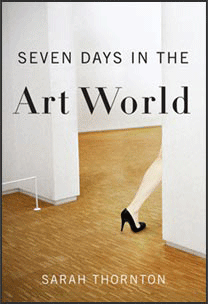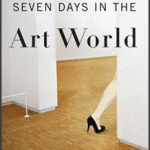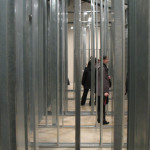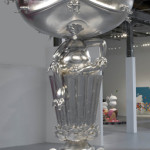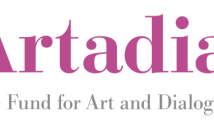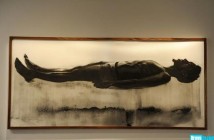SEVEN DAYS IN THE ART WORLD BY SARAH THORTON
Noted cultural sociologist Sarah Thorton (she has written on rave culture: Club Cultures: Music, Media, and Subcultural Capital as well as for the BBC, and NPR) has turned her attention and considerable analytical skills towards the art world with her book Seven Days in the Art World. The book consists of seven chapters tackling seven different " day-in-the-life" case studies in the contemporary art world: a Christie's auction, art school seminar at Cal Arts, a day at Artforum, a visit to Takashi Murakami's studio, the Art Fair in Basel, and the Turner Prize. The book itself is a fun read that doesn't get too bogged down in intellectualism and over-analysis. That in itself is indicative of Thorton's close (perhaps too close) relationship with the art community. It is long on observation and short on weight. There are moments where I smiled in recognition and others where I groaned in annoyance. But one of the more remarkable things about the book is it's timing. It is a window into the zeitgeist. As we confront dire economic times Thorton's book offers up a tale of what happens at the height of a cultural moment and the exuberance of an overheated market.
She starts the book off with a somewhat critical eye. She notes that the art world is " rife with conformity. Artists make work that 'looks like art' and behave in ways that enhance stereotypes. Curators pander to the expectations of their peers and their museum boards. Collectors run in herds to buy work from a handful of fashionable painters. Critics stick their fingers in the air to see which way the wind is blowing so as to 'get it right.' Originality is not always rewarded." Now, I agree with some of these statements. Who doesn't know people like this? One would expect Thorton to present a critical analysis of these case studies based upon her initial set-up. She certainly sounds like that is her plan. And in a way she does back up this thesis with the data. The people included certainly sound like this. But I couldn't help but think she was picking anecdotes that simply confirmed this statement. Did she seek out the curator who doesn't pander? I certainly could have suggested a couple of people for her to speak to. Does she include the artist who is truly attempting to make work that speaks truth and runs counter to " art that looks like art?" I have no idea because they don't come up. It is quite frustrating.
She begins with the auction. Fascinating in and of itself, the Christie's auction is a look at a world far removed from the art world that I navigate. The fever and excitement of the money and power at work make for a captivating read. Thorton touches upon the hierarchies inherent in the seating chart, the hierarchies in the art that is sold, and the deft maneuvering of the Christie's staff. It is fun and galling at the same time. Collectors boast and brag over work they own and how they bought it before anyone else. The collector David Teiger (number 28 on ArtReview magazine's list of top 100 Art Figures) has an interchange with another person at the auction where he reveals that although he collects art by young artists he doesn't necessarily like it. But he buys it anyway. And her observations of New York Time art columnist Carol Vogel are priceless, referring to her as the " haughty embodiment of the power of her newspaper."
Case study number two deals with the Art Crit. Here she travels to the California Institute of the Arts (Cal Arts). She spends the day sitting in on conceptual artist Michael Asher's MFA Post-Studio crit class and proceeds to write a stereotypical review of what happens in a crit class. It is, in a way, the most fun and one of the more annoying moments in the book. Annoying in that it accurately depicts a crit (an event that many of us can recognize and identify with). I found this annoying because somehow she just didn't get it. Is this because in art school you have to believe that this is a helpful process? It made me realize that the crit truly is an experience that many people would have a hard time understanding. To this day no matter where I work or what I do I can take criticism. I've learned how. There is a truth to Thorton's observations that I couldn't deny even when I felt that the people she talked about were irritating. But you know, there were always people in my crit class that irritated me. And this is also what made the chapter quite fun. It was like a little flashback for me. What was the most fascinating thing about the class is that Michael Asher, world famous conceptual artist and teacher, barely speaks during this twelve hour long crit session. The students do all the talking. I wasn't sure if I'd be in awe or just want to smack him aside the head.
Next is Art Basel and the cast of characters gets really absurd. The extremely wealthy art collectors and those whose lives and careers revolve around them converge on the little Swiss city of Basel. Thorton's tale takes a turn towards the people who manage galleries and the art market. We meet the two owners of Blum & Poe a gallery in Los Angeles and known for " discovering artists and launching their careers." This is where I get one of my favourite quotes from this book (there are a bunch I've committed to memory), " we're very West Coast. So our success freaks some people out. We've played it the way we wanted. That's why we are doing well for our artists. We believe in them and we work like motherfuckers." Um, okay. They happen to represent Takashi Murakami and will reappear later in the book. If you thought they were obnoxious in chapter three just wait till chapter six. There is a certain irony in the fact that Murakami's work is suddenly not selling. Especially since this little tale involves the excitement and fervor around the sale of one of his paintings for one point four million. Hope they invested that money. Whoops maybe not. Quote for this chapter " Sometimes I'm embarrassed to identify myself as a collector. There is an implied incompetence. Out of everyone in the art world, collectors are the least professional. All they have to do is write a check."
And then there is the Turner prize. Interesting for it's detail and history but honestly I felt like all the hype around this prize feels a little bit like a weird British game show. You have an idea of the participants (or sometimes not) and you know how it all works but you just can't seem to care. I feel like it really only interests the people who are eligible. She does spent some time with Phil Collins, who's work I quite like, but otherwise...moving on to a day at Artforum. I wanted this one to be interesting. I'm not sure I really cared about it enough though. I was curious to get a peek into a magazine that has such a hold on the art community. I think a sure fire way to get a dirty look at an art event is to tell people you don't read it. That is one way to devalue yourself. Again, much like the Turner chapter, I felt that it simply demystified. Not a bad thing. Big RED & Shiny fashions itself as an art journal so it is worthwhile to see just how they functioned but ultimately it is a magazine. And the details of putting together a magazine just isn't that interesting. It does have a great quote though. Rhonda Lieberman, writer and contributing editor notes " within Artforum's sleek upmarket exteriour is this endless blowing of windbags who lift and separate art form the marketplace through a strategic use of theory." Nicely said.
The last two chapters examine Takashi Murkami's studio and the Venice Biennale. The first is a pretty fun jaunt around Japan with Murakami's dealers, the aforementioned Blum & Poe. This is in preparation for his monumental retrospective at the Museum of Contemporary Art in Los Angeles. They are flying over to take a look at the finished sculpture Oval Buddha. Here you get a look at Murkami's vast corporation. The man is an industry unto himself. Whether you like him or not, his methodologies are pretty spectacular. Murakami has certainly taken the commodification of art to it's extreme. The artwork is made in an assembly line manner with hundreds of assistants. But make no mistake, Murakami rules over all and you better get it right. Sure, all of his assistants are working artists and he does go above and beyond helping them get shows of their own but seriously? " Two women had laid the second and third paintings flat on a long trestle table. One sat cross-legged on the floor with her eyes two inches away from the picture's edge. She had a thin round bamboo brush in her left hand and a Q-tip tucked into her hair. The other, an artist names Rei Sato, knelt on the floor reapplying platinum particles. They were all wearing white gloves with the thumbs and forefingers cut out. No one had more than a speck or two of paint on his or her clothes. They worked in silence or in their own iPod worlds. When I asked Sato if there was any room for creativity in the work, she replied, 'none at all.'" I think I would go insane.
By the time Thorton gets to Venice I am fried and over the art world. I now know too much. As I read the book the economic situation around the world worsened and I felt that all of these people lived in a bubble that soon came crashing down around them. In recent weeks the auction houses began laying people off. Sales expectations for upcoming contemporary auctions were significantly lowered and work by Murakami and Jeff Koons sit unsold. There is a moment when Thorton is at Basel speaking with an American collector. With absolutely no trace of irony, as they speak of the " art bubble," he makes this wonderful observation " A bubble misunderstands the economic realities. Only a century ago, no one had a car. Now people have two or three. That's the way it's going to be with art." Indeed? A year later people sit around trying to figure out how they are going pay for those two or three cars with no job. Will this years Venice be as exuberant as the one Thorton describes? We'll see.
And this is the most worthwhile aspect of this book. It is like reading about the roaring twenties. It is a window into a period in culture when people spent lots of money and it felt like the good times could never end. Hedge funders, artists, dealers, and the crowd around... all bought into the bubble. We could all get rich through art. It was one big circle of money. Now that most of that has gone perhaps we can get back to the simple aspects of art? This book is something that anyone interested in a cultural movement should read. But I think it is especially eye opening for artists. Take a look at this world and realize just how crazy it was. It isn't the critical examination I was hoping for but it is still pretty damn interesting.
- Sarah Thorton, Seven Days in the Art World, W.W. Norton Publishers, 2008.
- Michael Asher, Michael Asher Installation, Mixed Media, 2008. Santa Monica Museum of Art.
- Takashi Murakami, Oval Buddha, Mixed Media, 2007.
"Seven Days in the Art World" is published by W.W. Norton in the United States.
All images are courtesy of the author and the artists.

